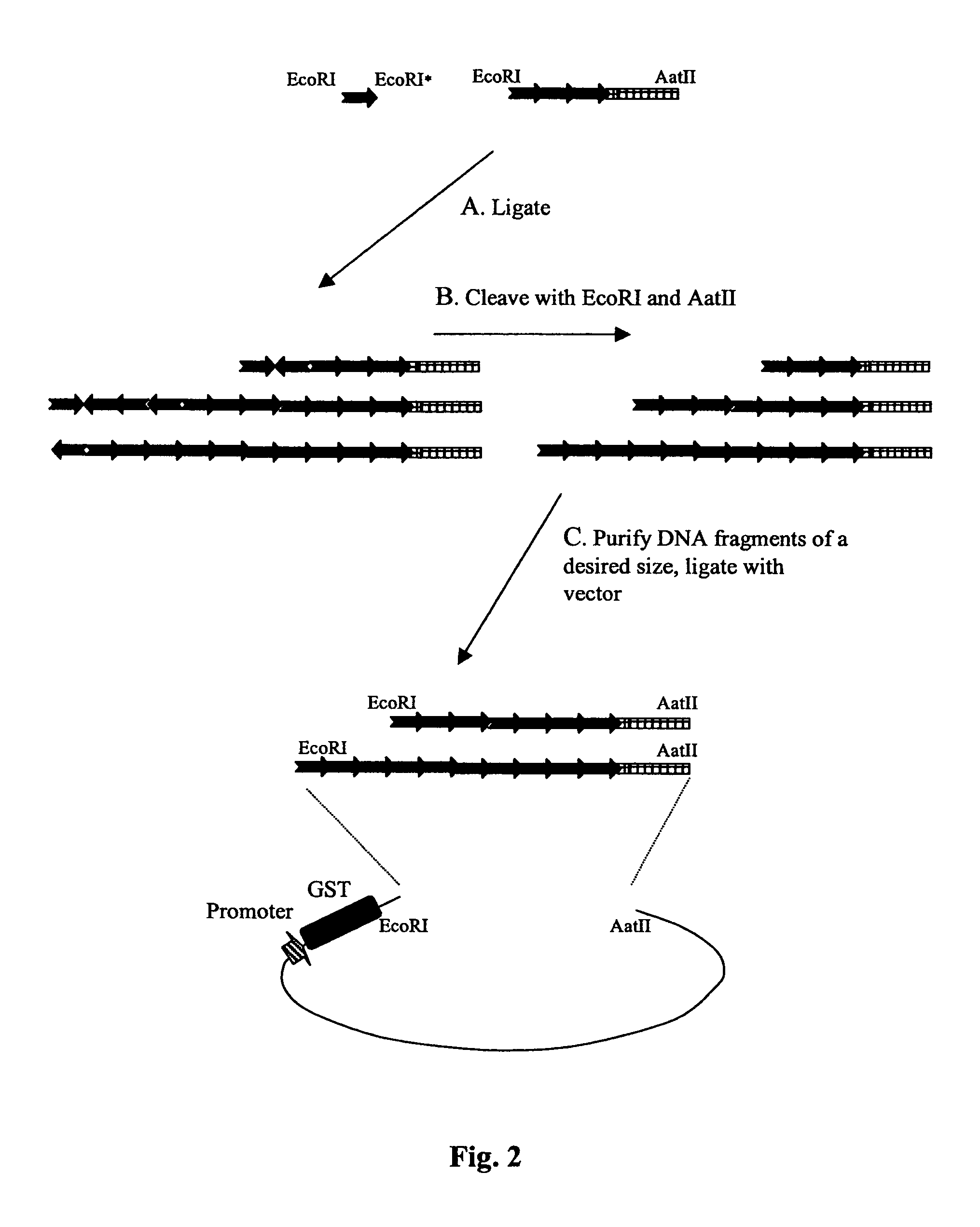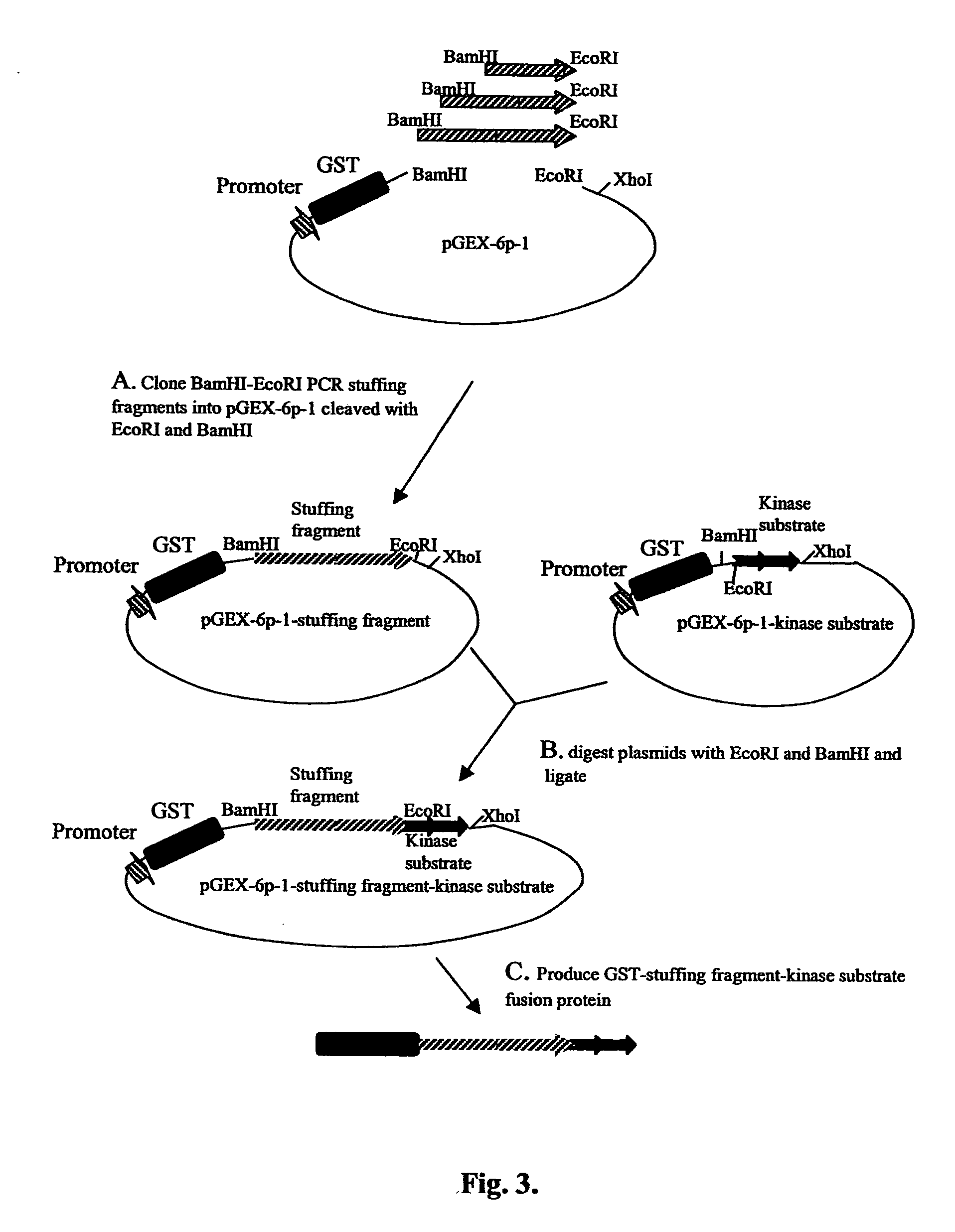Protein kinase and phosphatase substrates and multiplex assays for identifying their activities
a technology of protein kinase and substrate, which is applied in the direction of enzymology, biochemistry apparatus and processes, transferases, etc., can solve the problems of inability to apply to a complex protein mixture containing many kinases, multiple different peptide substrates cannot be conveniently used to detect different protein kinases in a single sample, and products limited to testing 1-2 activities are not very informativ
- Summary
- Abstract
- Description
- Claims
- Application Information
AI Technical Summary
Benefits of technology
Problems solved by technology
Method used
Image
Examples
example 1
Plasmid Constructs Encoding Protein Kinase Substrates
[0123] A protocol was developed for construction of plasmid vectors expressing protein kinase substrates (FIG. 1). pGEX-6p-1 vector (Amersham Pharmacia Biotech) was used as the parent vector to express protein kinase substrate peptides as carboxy-terminal fusions with GST. Synthetic oligonucleotides encoding protein kinase substrate peptides were designed based on the literature data (Table 1).
TABLE 1Protein kinase peptide substrate and dsDNA oligonucleotidesequences used to generate GST fusion kinase substrate proteins.*KinasePeptide and oligonucleotide sequences1Abl A I Y A A P P(SEQ ID NO: 7)AATTCGCGATTTATGCGGCGCCGTTTC(SEQ ID NO: 8) GCGCTAAATACGCCGCGGCAAAGTTAA(SEQ ID NO: 9)2CHK D Q E A K V S R S G L Y R S P S M P E N L N(SEQ ID NO: 10)AATTCGATCAGGAAGCGAAAGTGAGTGCGAGTGGTCTGTATCGTTCTCCGTCTATGCCGGAAAACCTGAACC(SEQ ID NO: 11) GCTAGTCCTTCGCTTTCACTCACGCTCACCAGACATAGCAAGAGGCAGATACGGCCTTTTGG...
example 2
Plasmid Constructs Encoding Stuffing Fragments
[0130] Different numbers of monomers often provide satisfactory variation in size of the protein kinase or protein phosphatase substrates. However, in some cases it is desirable to provide a larger range of sizes of substrates, especially in the higher than 50 kDa molecular weight range, in order to be able to combine them into multiplex mixtures, which can be conveniently separated on SDS-PAGE gels. Furthermore, it has been found that some GST-protein kinase fusions can be insoluble under certain conditions. However, typically it is possible to recover sufficient quantities of soluble substrate when a stuffing fragment is incorporated into the fusion protein. To this end, DNA fragments encoding additional peptide sequences (stuffing fragments encoding stuffing peptide sequences) were inserted in-frame with the GST tag and with the protein kinase substrate to increase the size of the substrate fusion protein.
[0131]E. coli β-galactosida...
example 3
Production of GST Fusion Kinase Substrates
[0136] GST fusion protein kinase substrates were produced as originally described for production of GST fusion proteins with minor modifications (Smith DB and Johnson K S, Single-step purification of polypeptides expressed in E. coli as fusions with glutathione S-transferase. Gene, 67: 31-40, 1988).
[0137] In brief, overnight cultures of XL10-Gold E. coli transformed with plasmid vectors providing for expression of GST-tagged protein kinase substrates were diluted 1:10 in 250 ml of fresh LB medium and grown for 1 h at 37° C. before adding IPTG (Stratagene) to 0.1 mM. After further 3 hours of growth, cells were pelleted and resuspended in 1 / 50 volume of PBS, and protease inhibitors cocktail (Roche Diagnostics Gmbh, Cat #1 697 498) was added according to the manufacturer's instructions. Cells were sonicated at mild sonication using Branson 250 Sonifier at output 40 on ice for 0.5 min, after which Triton X-100 was added to 1% concentration and...
PUM
| Property | Measurement | Unit |
|---|---|---|
| molecular weight | aaaaa | aaaaa |
| molecular weight | aaaaa | aaaaa |
| molecular weight | aaaaa | aaaaa |
Abstract
Description
Claims
Application Information
 Login to View More
Login to View More - R&D
- Intellectual Property
- Life Sciences
- Materials
- Tech Scout
- Unparalleled Data Quality
- Higher Quality Content
- 60% Fewer Hallucinations
Browse by: Latest US Patents, China's latest patents, Technical Efficacy Thesaurus, Application Domain, Technology Topic, Popular Technical Reports.
© 2025 PatSnap. All rights reserved.Legal|Privacy policy|Modern Slavery Act Transparency Statement|Sitemap|About US| Contact US: help@patsnap.com



